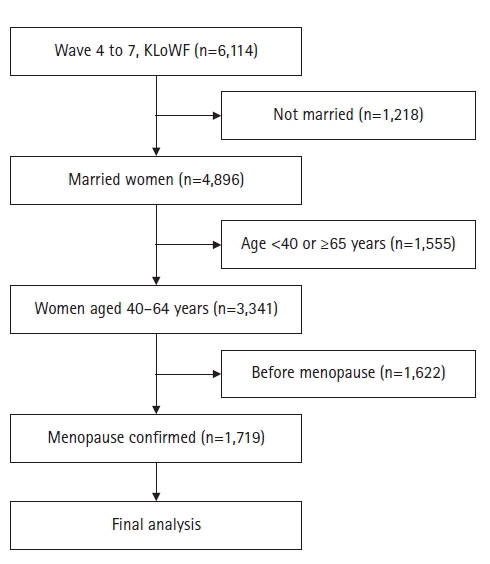1. Karmakar N, Majumdar S, Dasgupta A, Das S. Quality of life among menopausal women: a community-based study in a rural area of West Bengal. J Midlife Health. 2017; 8(1):21–27.
https://doi.org/10.4103/jmh.JMH_78_16.

2. Mathew DJ, Kumar S, Jain PK, Srivastava DK, Singh V, Krishnappa K. Morbidity patterns among menopausal women in rural Uttar Pradesh, India: A Cross-Sectional Study. J Menopausal Med. 2021; 27(1):24–31.
https://doi.org/10.6118/jmm.19022.

3. Idiana HI, Nik Hazlina NH, Zaharah S, Azidah AK, Mohd Zarawi MN. Developing and validating the Menopausal Spousal Support Questionnaire (MSSQ) for menopausal women. Maturitas. 2022; 158:1–9.
https://doi.org/10.1016/j.maturitas.2021.10.005.

4. Jeong YR, Jeong SH, Han SS. The relationship between husband support and depression in Korean married women: the mediating effects of connubial bliss. J Korea Content Assoc. 2018; 18(12):263–271.
https://doi.org/10.5392/JKCA.2018.18.12.263.

5. Yazdkhasti M, Simbar M, Abdi F. Empowerment and coping strategies in menopause women: a review. Iran Red Crescent Med J. 2015; 17(3):e18944.
https://doi.org/10.5812/ircmj.18944.

6. Kim E, Kim H, Yoon JY. Trajectories of self-rated health among one-person households: a latent class growth analysis. J Korean Acad Community Health Nurs. 2019; 30(4):449–459.
https://doi.org/10.12799/jkachn.2019.30.4.449.

7. Freidoony L, Chhabi R, Kim CS, Park MB, Kim CB. The components of self-perceived health in the Kailali district of Nepal: a cross-sectional survey. Int J Environ Res Public Health. 2015; 12(3):3215–3231.
https://doi.org/10.3390/ijerph120303215.

13. Bronfenbrenner U, Morris PA. Handbook of child psychology. The bioecological model of human development. 6th ed.
RM Lerner
W Damon
. Hoboken, NJ: John Wiley & Sons;2006. p. 793–828.
14. Bae GI. An ecosystematic approach to childbirth of married women: comparison between the first childbirth and the second childbirth. Korean J Soc Welf Stud. 2020; 51(1):275–301.
15. Pfefferbaum RL, Jacobs AK, Noffsinger MA, Pfefferbaum B, Sherrieb K, Norris FH. The burden of disaster: part II. applying interventions across the child’s social ecology. Int J Emerg Ment Health. 2012; 14(3):175–187.
16. Lee Y, Kang J. Related factors of turnover intention among Korean hospital nurses: a systematic review and meta-analysis. Korean J Adult Nurs. 2018; 30(1):1–17.
https://doi.org/10.7475/kjan.2018.30.1.1.

17. Glanz K, Rimer BK, Viswanath K. Health behavior: theory, research, and practice. 5nd ed. San Francisco: Wiley;2015.
19. Gold EB, Crawford SL, Avis NE, Crandall CJ, Matthews KA, Waetjen LE, et al. Factors related to age at natural menopause: longitudinal analyses from SWAN. Am J Epidemiol. 2013; 178(1):70–83.
https://doi.org/10.1093/aje/kws421.

20. Choi HG, Kim HJ. Comparison of health-related habits and metabolic syndrome risk factors according to obesity type in Korean postmenopausal women. Menopause. 2020; 27(9):1022–1029.
https://doi.org/10.1097/GME.0000000000001569.

21. Yang HM. How work environment, work-family conflict, and job satisfaction are relevant to the self-rated health of married working women. Women Stud. 2020; 105(2):105–131.
https://doi.org/tws.2020.105.2.004.

23. Fu Y, Lin W, Yang Y, Du R, Gao D. Analysis of diverse factors influencing the health status as well as medical and health service utilization in the floating elderly of China. BMC Health Serv Res. 2021; 21(1):438.
https://doi.org/10.1186/s12913-021-06410-7.

24. Park SY, Park SY. A longitudinal study on ecological determinants associated with middle-aged and elderly women’s life satisfaction and depressive symptoms. Health Soc Welf Rev. 2018; 38(4):129–163.
https://doi.org/10.15709/hswr.2018.38.4.129.

26. Kim J. Influential factors of social relation on the change in the depression level of elderly: longitudinal analysis using a latent growth model. J Korea Contents Assoc. 2019; 19(7):138–148.
https://doi.org/10.5392/JKCA.2019.19.07.138.

27. Choi YJ, Kim HY. Analyzing changes and determinants of self-rated health during adolescence: a latent growth analysis. Child Health Nurs Res. 2018; 24(4):496–505.
https://doi.org/10.4094/chnr.2018.24.4.496.

28. Bae BR. Structural equation modeling with Amos 23: Principles and practice. Seoul: Chungram;2018.
29. Campbell KE, Dennerstein L, Finch S, Szoeke CE. Impact of menopausal status on negative mood and depressive symptoms in a longitudinal sample spanning 20 years. Menopause. 2017; 24(5):490–496.
https://doi.org/10.1097/GME.0000000000000805.

30. Del Sueldo M, Martell-Claros N, Abad-Cardiel M, Zilberman JM, Marchegiani R, Fernández-Pérez C. Health perception in menopausal women. Int J Womens Health. 2018; 10:655–661.
https://doi.org/10.2147/IJWH.S173891.

31. Gomina M, Ele RN, Imorou RS, Alassani A, Djidonou G, Sina H, et al. Prevalence and factors associated with dyslipidemia among menopausal women in the city of Parakou (Benin). Int Res J Biochem Bioinform. 2017; 7(1):12–18.
https://doi.org/10.14303/irjbb.2017.011.

32. Hellgren MI, Kitsche E, Groot-Zevert M, Lindblad U, Daka B. Association between body mass index and self-rated health: a Swedish population-based longitudinal study. Scand J Public Health. 2021; 49(4):369–376.
https://doi.org/10.1177/1403494819875012.

33. Lee HM, Chung HJ, Jung IK. Relationships among metabolically healthy status, physical activity, and sedentary behavior according to obesity in low-income menopause women. Asian J Phys Educ Sports Sci. 2020; 8(2):75–89.
https://doi.org/10.24007/ajpess.2020.8.2.007.

34. Du Bois SN, Yoder W, Ramos SD, Grotkowski K, Sher TG. Unexpected gender moderation of marital satisfaction–health associations in long-distance relationships. Fam J. 2019; 27(2):133–141.
https://doi.org/10.1177/1066480719826300.

36. Lee Y. Childbirth and change in marital satisfaction of wives: the mediating effects of changes in leisure with husbands and in their housework. Korean J Fam Welf. 2019; 24(4):519–538.
https://doi.org/10.13049/kfwa.2019.24.4.4.

38. Yang H, Deng Q, Geng Q, Tang Y, Ma J, Ye W, et al. Association of self-rated health with chronic disease, mental health symptom and social relationship in older people. Sci Rep. 2021; 11(1):14653.
https://doi.org/10.1038/s41598-021-94318-x.

39. Kim KA, Hwang SY. Effects of a daily life-based physical activity enhancement program for middle-aged women at risk for cardiovascular disease. J Korean Acad Nurs. 2019; 49(2):113–125.
https://doi.org/10.4040/jkan.2019.49.2.113.

40. Cho OH, Hwang KH. Comparison of quality of life and related factors according to premature menopause using the Korea National Health and Nutrition Examination Survey (2014–2017). Korean J Women Health Nurs. 2020; 26(2):131–140.
https://doi.org/10.4069/kjwhn.2020.03.27.

41. Chen GC, Arthur R, Iyengar NM, Kamensky V, Xue X, Wassertheil-Smoller S, et al. Association between regional body fat and cardiovascular disease risk among postmenopausal women with normal body mass index. Eur Heart J. 2019; 40(34):2849–2855.
https://doi.org/10.1093/eurheartj/ehz391.

43. JafariNasabian P, Inglis JE, Reilly W, Kelly OJ, Ilich JZ. Aging human body: changes in bone, muscle and body fat with consequent changes in nutrient intake. J Endocrinol. 2017; 234(1):R37–R51.
https://doi.org/10.1530/JOE-16-0603.

44. Naworska B, Brzęk A, Bąk-Sosnowska M. The relationship between health status and social activity of perimenopausal and postmenopausal women (health status and social relationships in menopause). Int J Environ Res Public Health. 2020; 17(22):8388.
https://doi.org/10.3390/ijerph17228388.






 PDF
PDF Citation
Citation Print
Print




 XML Download
XML Download